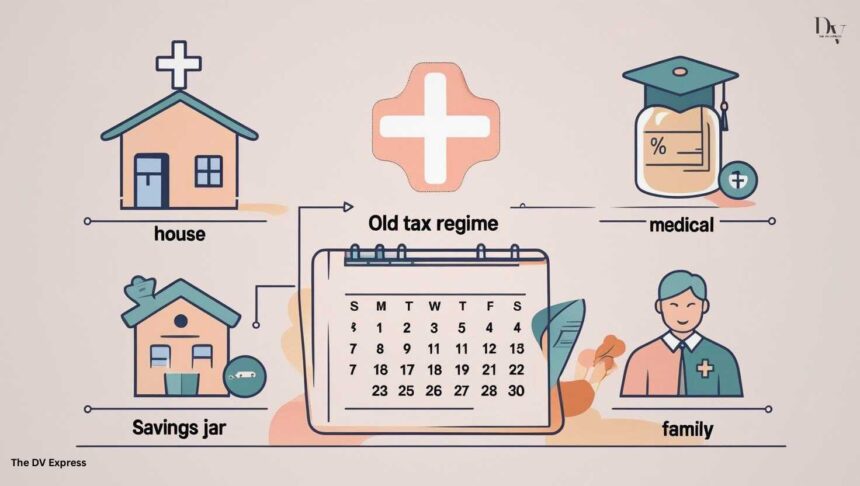The clock is ticking, and I can already feel the familiar pre-deadline anxiety that hits every taxpayer around this time of year. With over 67 lakh ITRs already filed by June 30, 2025, many of us are scrambling to get our paperwork in order before the September 15 deadline for FY 2024-25 (AY 2025-26).
Here’s what’s keeping me up at night – and should concern you too: while ITR-1 and ITR-4 forms are available online, ITR-2 and ITR-3 are still missing in action. This means we’re heading straight into a last-minute filing frenzy that could cost you dearly if you’re not prepared.
I’ve seen too many people rush through their ITR filing and miss out on legitimate deductions worth thousands of rupees. The worst part? Once you’ve filed your return for a specific financial year, you can’t go back and claim those missed deductions in future years. They’re gone forever.

Let me walk you through the five most valuable tax deductions you absolutely cannot afford to overlook under the old tax regime. These aren’t just theoretical savings – they’re real money that stays in your pocket instead of going to the tax department.
Why Missing These Deductions Costs You More Than You Think
Before we dive into the specifics, here’s a reality check that might surprise you. Let’s say you’re in the 20% tax bracket and you miss claiming a ₹1 lakh deduction under Section 80C. That’s ₹20,000 in unnecessary taxes you’ll pay – money that could have funded your child’s education, your vacation, or simply stayed in your savings account.
The Income Tax Act is crystal clear about this: if you don’t claim eligible deductions in the year you made those investments or payments, you’ve lost that opportunity forever. There’s no provision for claiming past deductions in subsequent years.

1. Health Insurance Premium Deductions Under Section 80D – Your Medical Safety Net with Tax Benefits
Health insurance isn’t just about protecting yourself from medical emergencies anymore – it’s one of the smartest tax-saving tools available. Here’s how Section 80D can work in your favor:
For Individuals Under 60 Years
You can claim up to ₹25,000 as a tax deduction for health insurance premiums paid for yourself, your spouse, and dependent children. This isn’t just a number on paper – it translates to real tax savings based on your income slab.
The Parent Coverage Advantage
Here’s where it gets interesting. You can claim an additional ₹25,000 for your parents’ health insurance if they’re under 60. But if your parents are senior citizens (60 or above), this limit jumps to ₹50,000.
I’ve noticed many people don’t realize there’s also a ₹5,000 deduction available for preventive health checkups since FY 2015-16. However, this ₹5,000 is included within the overall limits mentioned above, not additional to them.
The Senior Citizen Medical Expenditure Option
If you’re not paying health insurance premiums for senior citizen parents, you have an alternative. You can claim up to ₹50,000 for actual medical expenses incurred on senior citizen parents. This flexibility is particularly useful when dealing with chronic conditions or unexpected medical procedures.
Real-World Impact: Let’s say you’re paying ₹15,000 for your family’s health insurance and ₹40,000 for your 65-year-old parents’ coverage. That’s ₹55,000 in total deductions under Section 80D, potentially saving you ₹11,000-₹16,500 in taxes depending on your tax bracket.
2. Employees Provident Fund (EPF) Contributions Under Section 80C – Building Retirement Wealth Tax-Free
If you’re a salaried employee, your EPF contribution is probably the easiest tax deduction you’ll ever claim. Here’s what you need to know about maximizing this benefit:
The 12% Standard Contribution
Every salaried employee contributes 12% of their basic salary to EPF, and your employer matches this contribution. While both go into your retirement fund, you can only claim a tax deduction for your own contribution under Section 80C.
Voluntary Provident Fund (VPF) – Going Beyond the Basics
Want to save more? You can opt for VPF to contribute additional amounts beyond the mandatory 12%. However, there’s a catch – your total EPF and VPF contributions cannot exceed your basic salary in any financial year.
The New Tax Reality on EPF Interest
Here’s something that changed the game starting FY 2021-22: EPF interest isn’t completely tax-free anymore. If your annual contributions to EPF and VPF exceed ₹2.5 lakh, the interest earned on the excess amount becomes taxable.
Additionally, if your employer’s total contributions to EPF, NPS, and superannuation fund cross ₹7.5 lakh in a financial year, the income on the excess amount is taxable for you.
Strategic Tip: If you’re a high earner, calculate your contributions carefully. Sometimes, it makes sense to diversify your tax-saving investments rather than putting everything into EPF and VPF.

3. Public Provident Fund (PPF) Investment Under Section 80C – The Triple Tax Advantage
PPF remains one of my favorite tax-saving instruments, and here’s why it should be on your radar too:
The EEE Status Advantage
PPF enjoys ‘Exempt-Exempt-Exempt’ status, which means:
- Investment qualifies for tax deduction (up to ₹1.5 lakh under Section 80C)
- Interest earned is completely tax-free
- Maturity amount is tax-free
This triple benefit is rare in the investment world and makes PPF incredibly attractive for long-term wealth building.
The 15-Year Commitment
PPF comes with a 15-year lock-in period, which can be extended in blocks of 5 years if needed. While this might seem restrictive, it forces disciplined long-term saving and compounds your wealth effectively.
Current PPF Interest Rate Reality
For FY 2024-25, the PPF interest rate stands at 8.1% per annum. While this has fluctuated over the years, the tax-free nature of this interest makes it quite attractive compared to taxable fixed deposits.
Planning Insight: If you haven’t started a PPF account yet, don’t wait. The 15-year rule means the sooner you start, the sooner you can access your maturity benefits. Even if you’re 45 today, starting PPF ensures tax-free income when you’re 60.
4. Equity Linked Savings Scheme (ELSS) Mutual Funds Under Section 80C – Growth with Tax Benefits
ELSS mutual funds offer a unique combination of tax savings and wealth creation potential. Here’s why they deserve serious consideration:
The Shortest Lock-in Period Advantage
Among all Section 80C investment options, ELSS funds have the shortest lock-in period of just three years. This gives you much more liquidity compared to PPF’s 15-year lock-in or insurance policies’ lengthy terms.
Market-Linked Returns Potential
Unlike fixed-return instruments, ELSS funds invest in equity markets, offering potential for higher returns over the long term. Historical data shows that well-managed ELSS funds have delivered returns in the range of 12-15% annually over extended periods.
The Taxation Reality on Redemption
Here’s the catch you need to understand: while you get a tax deduction for investing in ELSS, any gains at redemption are taxable as per capital gains tax rules. Currently, long-term capital gains above ₹1 lakh per year are taxed at 10%.
Expert Insight on ELSS Claiming Rules
Chartered Accountant Abhishek Soni, co-founder of Tax2Win, clarifies a common misconception: “If you invested ₹50,000 in ELSS in FY 2022-23 but only claimed ₹20,000 as deduction that year, you cannot claim the remaining ₹30,000 in subsequent years. Deductions under Section 80C must be claimed in the same financial year when the investment was made.”
Investment Strategy: Consider systematic investment plans (SIPs) in ELSS funds to average out market volatility while building your tax-saving corpus over time.
5. Interest Income Deductions – Don’t Overlook These Hidden Gems
Most people focus on big-ticket deductions and completely miss the smaller ones that can add up significantly. Let me break down two important interest-related deductions:
Section 80TTA for Individuals Below 60
If you’re under 60, you can claim up to ₹10,000 as deduction on interest earned from:
- Savings bank accounts
- Cooperative bank accounts
- Post office savings accounts
This deduction is available to resident individuals and Hindu Undivided Families (HUFs). Note that this doesn’t cover interest from fixed deposits or recurring deposits.
Section 80TTB for Senior Citizens – The Enhanced Benefit
Senior citizens (60 years and above) get a much better deal. They can claim up to ₹50,000 as deduction on interest income from:
- Savings accounts
- Fixed deposits
- Recurring deposits
- Post office deposits
Important Rule: You cannot claim benefits under both Section 80TTA and 80TTB in the same financial year. It’s one or the other.
Filing Requirements and Compliance
Dr. Suresh Surana, Chartered Accountant, explains the filing process: “The total interest earned must be disclosed under ‘Income from Other Sources’ in your ITR. Then claim the corresponding deduction under either Section 80TTA or 80TTB in the Chapter VI-A deductions schedule.”
Even if your interest income doesn’t appear in Form 16, Form 26AS, or the Annual Information Statement (AIS), you must report it accurately to avoid scrutiny from tax authorities.
Common Questions About Tax Deductions
Can You Claim Deductions for Family Members’ Investments?
This is a question I get frequently, and the answer might disappoint some people. You cannot directly claim tax deductions for investments made by your spouse or children from their own income.
However, there are legitimate ways to structure investments for maximum tax benefits:
Joint Investments Strategy:
- Joint home loans allow both spouses to claim separate deductions
- Joint life insurance policies can maximize Section 80C benefits
- Joint bank accounts can help optimize interest income deductions
What Happens If You Miss Claiming a Deduction?
Once you file your ITR for a financial year, any unclaimed eligible deductions are lost forever. The Income Tax Act doesn’t provide any mechanism to claim past deductions in subsequent years. This is why careful planning and thorough review before filing are crucial.
Documentation Requirements
While you don’t need to submit investment proofs with your ITR, maintain proper documentation. The tax department can ask for these during assessment or scrutiny. Keep receipts, certificates, and statements organized and easily accessible.
Strategic Planning for Maximum Tax Savings
The ₹1.5 Lakh Section 80C Limit Challenge
Section 80C has an overall limit of ₹1.5 lakh per financial year. This means if you’re contributing to EPF, investing in PPF, paying life insurance premiums, and investing in ELSS, your total deductions under this section cannot exceed ₹1.5 lakh.
Optimization Strategy: Calculate your automatic deductions (like EPF contributions) first, then allocate the remaining limit among PPF, ELSS, and other eligible investments based on your financial goals and risk appetite.
Balancing Old vs New Tax Regime
For AY 2025-26, you still have the choice between old and new tax regimes. The old regime allows these deductions, while the new regime offers lower tax rates but fewer deductions.
Decision Framework:
- Calculate tax liability under both regimes
- Consider your eligible deductions and investments
- Factor in your risk tolerance and investment preferences
- Remember that you can switch between regimes each year
Action Steps Before the September 15 Deadline
Immediate Tasks (Complete by July 15, 2025)
- Gather All Investment Documents: Collect certificates, receipts, and statements for all eligible investments and payments made in FY 2024-25.
- Calculate Total Deductions: Add up all your eligible deductions under various sections to see your total tax-saving potential.
- Review Missing Investments: If you haven’t reached the Section 80C limit of ₹1.5 lakh, consider making additional investments before the deadline.
Pre-Filing Checklist (Complete by August 31, 2025)
- Verify All Amounts: Cross-check investment amounts with bank statements and certificates.
- Organize Supporting Documents: Even though you don’t submit them with ITR, keep them ready for potential scrutiny.
- Calculate Tax Impact: Determine how much tax you’ll save with these deductions to verify the benefits.
Filing Best Practices
- Double-Check Calculations: Mathematical errors in claiming deductions can trigger notices from the tax department.
- Maintain Consistency: Ensure deduction amounts match your actual investments and payments.
- Keep Digital Copies: Scan and store all supporting documents digitally for easy access.
The Cost of Procrastination
Let me share a sobering reality: every year, thousands of taxpayers miss out on legitimate deductions worth lakhs of rupees simply because they rush through their ITR filing or aren’t aware of their entitlements.
Consider this scenario: A software engineer in the 30% tax bracket misses claiming ₹1.5 lakh under Section 80C, ₹25,000 under Section 80D, and ₹10,000 under Section 80TTA. That’s ₹1.85 lakh in unclaimed deductions, resulting in ₹55,500 in unnecessary taxes.
That ₹55,500 could have funded a family vacation, contributed to your child’s education fund, or simply enhanced your financial security. Once the ITR filing deadline passes, this money is gone forever.
Looking Ahead: Tax Planning for Future Years
While we’re focusing on AY 2025-26, smart tax planning is an ongoing process. Here are some forward-looking strategies:
Systematic Investment Approach
Instead of scrambling to make investments before each year’s deadline, consider systematic approaches:
- Monthly SIPs in ELSS funds
- Regular PPF contributions
- Automated transfers to tax-saving fixed deposits
Family Tax Planning
Coordinate tax planning across family members to maximize overall benefits. This includes:
- Strategic allocation of investments between spouses
- Optimal structuring of insurance policies
- Planning for dependent parents’ medical expenses
Documentation Systems
Develop a system for maintaining investment records throughout the year. This makes ITR filing smoother and ensures you don’t miss any eligible deductions.
Conclusion: Your Money, Your Choice
As we approach the September 15 deadline for AY 2025-26, remember that claiming these tax deductions isn’t just about compliance – it’s about keeping more of your hard-earned money in your pocket.
The five deductions we’ve covered – health insurance premiums, EPF contributions, PPF investments, ELSS mutual funds, and interest income deductions – represent thousands of rupees in potential tax savings. More importantly, they contribute to your long-term financial health through forced savings, insurance protection, and wealth creation.
Don’t let the last-minute filing rush cost you money that rightfully belongs to you. Take action now, gather your documents, calculate your eligible deductions, and file your ITR with confidence.
Your future self will thank you for the financial discipline and the extra money you’ve kept in your family’s hands instead of paying unnecessary taxes.
Remember: These deductions are use-it-or-lose-it opportunities. Once the financial year ends and you file your ITR, any unclaimed eligible deductions are lost forever.
Next Steps: Review your FY 2024-25 investments and payments, calculate your eligible deductions, and ensure you claim every rupee you’re entitled to under the old tax regime.
Frequently Asked Questions
Q: Can I switch from new tax regime to old tax regime for AY 2025-26? A: Yes, salaried individuals can switch between regimes each year. However, calculate tax liability under both regimes considering your eligible deductions before making the choice.
Q: What if I forgot to claim a deduction in last year’s ITR? A: Unfortunately, you cannot claim deductions for past years in your current year’s ITR. However, you can file a revised return for the previous year if it’s within the specified time limit.
Q: Are NRIs eligible for these deductions? A: NRI eligibility varies by section. For example, NRIs cannot claim Section 80TTA or 80TTB deductions, but may be eligible for others depending on their residential status and income sources.
Q: How do I know if my EPF interest will be taxable? A: If your annual EPF and VPF contributions exceed ₹2.5 lakh, interest on the excess amount becomes taxable from that financial year onwards.
Q: Can I claim Section 80D deduction for parents living abroad? A: Yes, you can claim deduction for health insurance premiums paid for parents, regardless of where they reside, as long as the policy is valid and premiums are paid by you.
About the Author:
Divyanshita Singh is a practicing Chartered Accountant and SEBI Registered Investment Advisor with 5+ years of experience in personal finance and investment planning. She has guided 200+ clients and managed portfolios worth over ₹2 crores. [Read full bio →]
